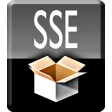Used Enterprise Architect for Windows?
Editors’ Review
Enterprise Architect is a modeling and architecture platform for defining and analyzing systems and processes. It supports UML, BPMN, ArchiMate, and SysML/SysML v2 artifacts in a central repository, linking requirements, architectural elements, and implementation. Tools cover diagramming, model validation, traceability matrices, document generation, code engineering, simulation, testing, and project views.
Enterprise Architect enables teamwork through Pro Cloud Server and WebEA for browser-based access and collaboration. Governance is maintained using perspectives and technology sets to shape toolboxes, ribbons, and modeling patterns. Time Aware Modeling handles baselined evolution. RAS packages model fragments for reuse. OSLC endpoints integrate data. Scripting automates modeling.
Architectural mastery
Enterprise Architect's modeling toolset creates and organizes UML, BPMN, ArchiMate, and SysML artifacts across packages in a repository. Elements are linked through connectors, stereotypes, and tagged values, with profiles and MDG Technologies supplying domain toolboxes and patterns. Validation runs rule checks on diagrams and elements. Requirements, use cases, components, and deployments link to test cases and source code, enabling round-trip class engineering and model-based document generation.
The repository supports traceability through matrices, relationship views, and impact analysis across requirements, architecture, and implementation items. Baselines capture package snapshots for comparison and merging, while the Reusable Asset Service distributes controlled model content. Pro Cloud Server provides HTTPS repository access. However, browser interaction is handled in WebEA rather than the desktop application. Security roles and perspectives constrain menus and toolboxes to set modeling scopes.
Model-Based Systems Engineering covers SysML v1.x and SysML v2 authoring with allocation, parametrics, and requirement traces. The Trechoro environment exposes SysML v2 and KerML constructs through graphical editors. Time Aware Modeling manages versioned model timelines of architectures. Project tools add Kanban boards, test management, and document pipelines. Simulation runs behavioral models. Code engineering generates and synchronizes classes. WebEA publishes content, and OSLC services expose artifacts.
Pros
- Multi-notation modeling across UML, BPMN, ArchiMate, SysML/SysML v2
- Central repository with traceability matrices and impact analysis
- Time Aware Modeling for versioned architectures
- Code engineering, simulation, and document generation
Cons
- Browser interaction is handled in WebEA rather than the desktop application
Bottom Line
End-to-end system modeling
Enterprise Architect delivers multi-notation modeling, traceability, validation, document generation, simulation, and code engineering within a central repository. Governance, baselines, and asset packaging support controlled model evolution. Collaboration and web access operate via Pro Cloud Server and OSLC services. SysML v2 capability is provided by the Trechoro environment with KerML support. However, the browser interaction is in WebEA rather than the desktop application.
What’s new in version 12-build-1215
- Changes to Add-In events
- Diagram rendering adjustments
- XMI 2.x export additions
Used Enterprise Architect for Windows?
Explore More

Geomatica FreeView
Free
Microsoft Agent 2.0 Add-in: SAPI 4 Control Panel Applet
Free
Socket Workbench
Trial version
Visual Studio 2005 Tools for Applications Software Development Kit (SDK)
Free
SSE Setup
Free
Microsoft MSXML 4.0 Security Update: XMLHTTP Control in MSXML 4.0 Can Allow Access to Local Files
Free
Altova MapForce Professional Edition
Trial version
Altova DiffDog Enterprise Edition
Trial version
Altova UModel Enterprise Edition
Trial version
Altova MapForce Enterprise Edition
Trial version
Altova MissionKit Professional Edition
Trial version
Altova Authentic Enterprise Edition
Trial version